|
|
 This photo of a Giant Pacific Octopus was taken at McCurdy Point in the Saanich Inlet. The octopus was swimming and was just about to 'land' when the picture was taken. The posture displayed by this octopus is one of transition. When they are about to land they spread out their legs below them.
This photo of a Giant Pacific Octopus was taken at McCurdy Point in the Saanich Inlet. The octopus was swimming and was just about to 'land' when the picture was taken. The posture displayed by this octopus is one of transition. When they are about to land they spread out their legs below them.
The octopus found in our region of the world are the largest found on earth. Jim Cosgrove, a local marine biologist and octopus expert, has seen an octopus that weighed seventy kilograms (one hundred and fifty pounds) and was seven meters long (twenty-three feet). Although they can grow to such an enormous size, it is more common for divers to see them from a few centimeters to about a meter in length.
|
|
 This octopus is swimming in midwater. When swimming, they keep all eight legs behind them in order to be as streamline as possible. They
propel themselves with jets of water from their siphon tubes. This octopus is swimming in midwater. When swimming, they keep all eight legs behind them in order to be as streamline as possible. They
propel themselves with jets of water from their siphon tubes. |
|
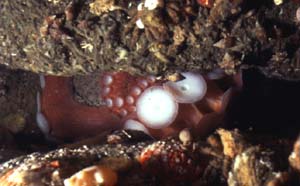
During the daytime octopus usually stay in their dens. Divers most commonly see octopus which are in their dens, as shown in this photo. |
|
 An octopus den is usually identified by a patch of crab or other type of shells near the entrance to the den. Octopuses eat a wide variety of things depending on what food is available in their area. Crabs, scallops, cockles, abalone, and most anything with a shell would be on the menu. They hunt primarily at night or on dark dreary days, which is therefore the best time to find them out and about. An octopus den is usually identified by a patch of crab or other type of shells near the entrance to the den. Octopuses eat a wide variety of things depending on what food is available in their area. Crabs, scallops, cockles, abalone, and most anything with a shell would be on the menu. They hunt primarily at night or on dark dreary days, which is therefore the best time to find them out and about. |
|
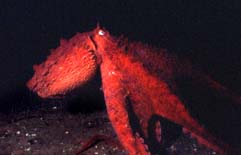 
Octopus have a few tricky defense mechanisms. Octopus can change the colour and texture of their skin in seconds in order to blend in and elude predators or ambush prey. Colour change is also used as a form of communication with other octopuses (and with us if you know how to read their color chart). They can change color in seconds in order to blend in and elude prey. Compare these two pictures. One is of a brown octopus and the other is of a red
octopus. Actually they are the same octopus and the pictures were taken seconds apart.
|
|

Another octopus trick is to squirt ink into the water and disappear into a 'cloud of smoke'. This octopus has just squirted
its ink (I think it was mad at us for following it around) and the ink has not yet
dispersed into a cloud.
|
|
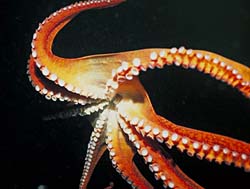
Octopuses have many weapons to use on their prey while they are hunting. They use venom to anaesthetize their prey so that they can continue collecting food before they go home and have a feast. Sensory organs on their suckers allow them to smell out prey. If there is a crab under a rock, an octopus can reach in with its arm, smell the crab, and then grab it with powerful arms and suckers. Once it has captured its prey, the octopus uses its powerful beak, much like the beak of a large parrot, to crack the shell. In the area where the octopus's arms meet in the middle of
its body, is where its beak is (you can't see the beak in this picture). It also has a tongue that serves as a drill when necessary. There are rasps on the end of the tongue, and when the octopus moves it back and forth it creates a hole in a shell that would otherwise be hard to crack.
|
|
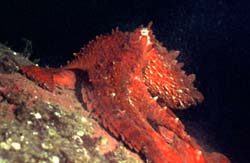 
Octopus are intelligent, graceful, beautiful creatures. Please donít try to handle them or remove them from their dens.
|
|
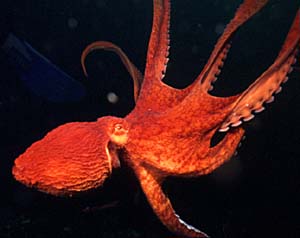 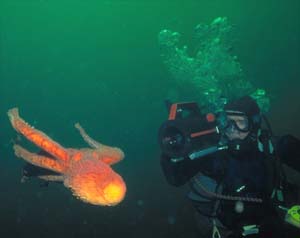
|
|

 This photo of a Giant Pacific Octopus was taken at McCurdy Point in the Saanich Inlet. The octopus was swimming and was just about to 'land' when the picture was taken. The posture displayed by this octopus is one of transition. When they are about to land they spread out their legs below them.
This photo of a Giant Pacific Octopus was taken at McCurdy Point in the Saanich Inlet. The octopus was swimming and was just about to 'land' when the picture was taken. The posture displayed by this octopus is one of transition. When they are about to land they spread out their legs below them.
 This octopus is swimming in midwater. When swimming, they keep all eight legs behind them in order to be as streamline as possible. They
propel themselves with jets of water from their siphon tubes.
This octopus is swimming in midwater. When swimming, they keep all eight legs behind them in order to be as streamline as possible. They
propel themselves with jets of water from their siphon tubes.
 An octopus den is usually identified by a patch of crab or other type of shells near the entrance to the den. Octopuses eat a wide variety of things depending on what food is available in their area. Crabs, scallops, cockles, abalone, and most anything with a shell would be on the menu. They hunt primarily at night or on dark dreary days, which is therefore the best time to find them out and about.
An octopus den is usually identified by a patch of crab or other type of shells near the entrance to the den. Octopuses eat a wide variety of things depending on what food is available in their area. Crabs, scallops, cockles, abalone, and most anything with a shell would be on the menu. They hunt primarily at night or on dark dreary days, which is therefore the best time to find them out and about.






